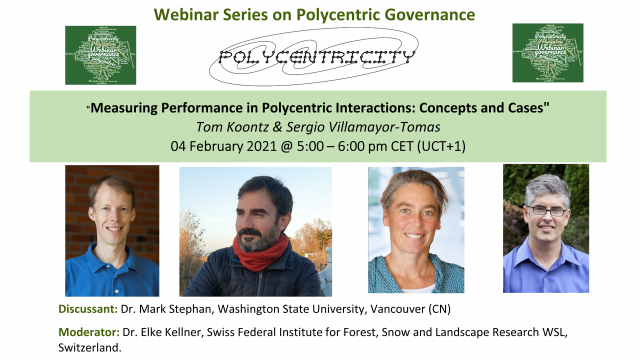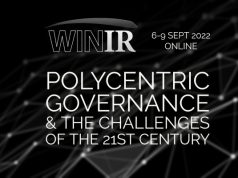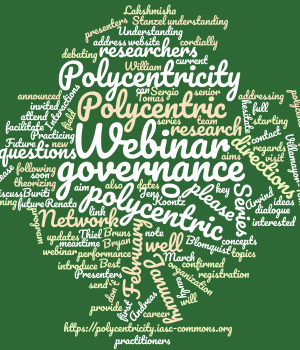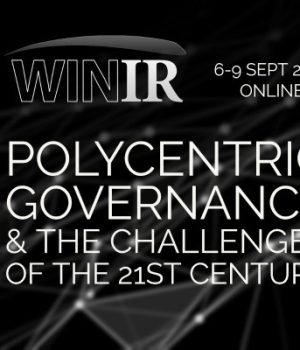In this post, Prof. Tom Koontz and Dr. Sergio Villamayor-Tomas address all questions from the Q&A section of Webinar Session 2 from the Webinar Series on Polycentric Governance.
Questions and answers are roughly grouped by themes such as general framework questions, practice, networks and institutions, fields of research (climate change, renewable energy), power and politics, types of interaction, factors affecting interactions, performance criteria (equity, efficacy and effectiveness, efficiency, coordination).
General framework questions
Q: Does polycentricity actually figures as a variable (or variables), or whether it’s more defining the overall setting of all the cases?
TK – R: In our work, polycentricity is more defining the overall setting. Other chapters of the book talk about degrees of more or less polycentricity, but here we analyze a foundational aspect present in all polycentric governance systems: interactions.
SVT – R: I agree. Some people are more interested in featuring varieties of polycentric governance systems while others are more interested in assessing performance. I guess the former approach requires more fine-grained descriptions of what PG actually is.
Q: What is an appropriate framework for performance assessment?
TK – R: A framework is a lens through which to examine some aspect of a system or process. Many frameworks can provide insights into performance. We argue that polycentricity is one such framework, and we develop concepts for what to look for within polycentric governance. By focusing on interactions, we believe we can measure performance by looking at processes and outcomes that result from interactions. We describe 7 performance criteria that might yield patterns across interaction types and highlight inherent trade-offs among some of these criteria.
SVT – R: We recognize that frameworks shall also include guidelines about how to use them. Although we do not provide explicit guidelines in the Governing Complexity book, we do provide examples that illustrate (one) way to apply it.
Q: How do you decide whether Institutional Analysis is an appropriate tool/framework to use on a particular transition, rather than other frameworks/tools?
TK – R: For me, I often start with institutional analysis because it’s what I am most familiar with. But there are many different frameworks that have been useful to analysts. Each framework views reality with a slightly different lens, so we can ask interesting questions about which framework is best suited to which issue area. (However, since this depends to some degree on epistemology and ontology, I doubt there would be agreement on this point!).
Practice
Q: How can polycentric governance arrangements existing in practice be evaluated and improved?
TK – R: We aim to provide tools for an analyst to focus on the interactions within polycentric governance. There are many different evaluative criteria, and different people prioritize different criteria.
SVT – R: How to “practice polycentrism” or “improve polycentric governance in practice” are intriguing questions (i.e., likely one that practitioners are quite interested in). Bryan Brun’s chapter in Governing Complexity book starts addressing that question.
Networks/ Institutions
Q: What is the relationship between networks and institutions?
TK – R: I view these concepts as affecting each other; institutions affect who is in networks and what actions people in such networks do, while networks can shape institutions. For example, a network of local organizations working on salmon recovery might together develop institutions to further their goals. At the same time, institutions might create opportunities and incentives for the organizations to pursue particular actions, such as developing habitat restoration plans.
SVT – R: Some scholars have recently started to think about networks of institutions.
- Heikkila, T., & Weible, C. M. (2018). A semiautomated approach to analyzing polycentricity. Environmental policy and governance, 28(4), 308-318.
- Weible, C. M., Yordy, J., Heikkila, T., Yi, H., Berardo, R., Kagan, J., & Chen, C. (2020). Portraying the Structure and Evolution of Polycentricity via Policymaking Venues. International Journal of the Commons, 14(1).
Q: How can we understand regional multi-actor network dynamics in the circular transition towards multiple value creation from the viewpoint of polycentric governance?
TK – R: From my perspective, multi-actor network dynamics might be examined by the interaction concepts of cooperation, conflict/conflict resolution, competition, and also how these interactions are shaped by authority, information, and resources.
SVT – R: Networks of Action situations have been recently used to address complex governance scenarios like the one described.
Q: How can network building mechanisms be encouraged? Is there any preference from your experience for a more top-down or a more bottom-up approach?
TK – R: I’ve seen a combination of both being useful. Sometimes a top-down approach brings together a variety of actors that then subsequently develop networks among themselves. But in my study context, an important determinant was the existing level of networks among actors. If actors are already well networked, then an additional top-down program might not yield much in the way of new networks. As for bottom-up, in many contexts, I’ve seen actors struggle to accomplish projects, which can lead to an effort dissolving and few networks being built or sustained. For watershed cooperation, it’s often the locally-based efforts that pull in government actors that can better sustain and develop networks, because government brings resources.
Climate Change/ Renewable Energy
Q: What are the determinants to be measured for the performance of polycentric governance regarding climate change issue?
TK – R: I would start with the 7 performance criteria we describe in our section of the book, which includes process criteria and outcome criteria. Then I would work backward to examine the interactions that led to different results for these criteria.
Q: Some developed countries have int’l development agencies that works with developing countries on climate change. Currently, renewable energy is not governed internationally. But there are these agencies (e.g. GIZ from Germany, JICA from Japan, GGGI from Korea etc). Focus and priorities may be different even on similar themes. Is the concept of polycentric governance or cooperation important on this?
TK – R: I am familiar with a study about how aid organizations affected collaborative interactions on the ground in India: Gupta and Koontz 2019 “Working Together? Synergies in Government and NGO Roles for Community Forestry in the Indian Himalayas.” World Development 114:326-340.
Power and Politics
Q: What is the role of power in polycentric governance and how it affects the interactions?
TK – R: Power can be directly related to authority – who is allowed or required to do which actions – in our framework, as well as to the “soft power” of giving resources with “strings attached” and guiding actions through information.
SVT – R: Check these refs.:
- Morrison, T. H., Adger, W. N., Brown, K., Lemos, M. C., Huitema, D., Phelps, J., … & Hughes, T. P. (2019). The black box of power in polycentric environmental governance. Global Environmental Change, 57, 101934.
- Morrison, T. H., Adger, W. N., Brown, K., Lemos, M. C., Huitema, D., & Hughes, T. P. (2017). Mitigation and adaptation in polycentric systems: sources of power in the pursuit of collective goals. Wiley Interdisciplinary Reviews: Climate Change, 8(5), e479.
Comment: power is also multidimension – not having resources or being vulnerable to withholding resources is power – not soft power. Authority can be thought of as soft power because it is (perceived) legitimate.
TK – R: Yes, there is some research on power in collaboration and in polycentricity that points to its multidimensionality (see for example Mudliar and Koontz 2021 https://doi.org/10.1080/08941920.2020.1864535)
Power and Politics
Q: Where does the top-down vs bottom-up approach fits in in this framework? For example, the independency of a wetland authority in some places are highly subjected to government interference and political motives. The community is also not empowered. In that case how do different nodes cooperate for a positive governance outcome?
TK – R: Yes, the government might interfere with local autonomy for things like wetlands or other domains. Much of the common pool resource literature speaks to the problems that arise when local governance is disregarded by actions of a central government. On the other hand, in the U.S. setting local watershed organizations are often empowered by state government involvement. It is also possible for local centers to cooperate to strengthen their position (there may be empirical studies that identify such cases, though none come to mind at the moment).
SVT – R: One can also understand PG lenses as a way to escape the traditional distinction between top-down and bottom-up policymaking. That said one can also explore the evolution of PG and there the distinction makes more sense. Many centralized governance systems have evolved into PGs via top-down decentralization policies. Conflict is a quite recurrent bottom-up way that PGs tend to emerge (like when middle-level governments come up with task forces resolving conflicts between central and local authorities).
Types of interactions
Q: How do you methodically differentiate between the three types of interactions? The perception of actors whether it is really about cooperation, i.e., whether they all pursue the same aim or not, may for example vary between the actors, or also change over time. And what about hybrid forms of interaction?
TK – R: I agree that our three interaction types do not occur in isolation. In fact, the conflict resolution cases often involved cooperation, and the competition cases included elements of cooperation. So one could examine how different interaction types co-occur, and also how they evolve over time. In our section of the book, we started more simply, to examine in-depth particular interaction types without also examining their interactions with other interaction types.
SVT – R: Thinking about coexisting modes of coordination in polycentric systems is at the frontier of research in polycentric governance. Many questions unsolved yet! Also, defining what is cooperation, competition or conflict is also a methodological choice, i.e., one that depends on the research question, researcher, and case at hand, like many others in social-environmental sciences. This does not mean that we cannot set conventions… I am not sure that we have clear conventions regarding the study of interactions of modes of coordination yet.
Q: Your presentations focused on diverse interactions in PG – competition, conflict, and cooperation; this is in the initial definition of PG that you referred to but it is something that is rarely researched as such in research on PG, neither interactions as such nor specific kinds of interactions like the ones you focus on and consider predominant in your cases. My questions are: why is research on PG rarely looking at these elements of interactions of the system (do you agree?)? What do you think? Do you think these are necessary ingredients of PG, specifically also this diversity of interactions and potentially the way they interrelate? How does this diversity relate to sometimes competing evaluative criteria? Finally, whose perspective did you adopt in evaluation and how do you think contradictory evaluative criteria relate to dynamics in PG?
TK – R: I think PG research from the Ostrom tradition had a keen interest in rules, rather than on drilling deep into specific kinds of interactions. I also think different types of interactions are associated with particular fields of study, for example, competition is largely examined in economics and political economy, whereas conflict/conflict resolution is its own field, and cooperation has been much studied by collaborative governance scholars. This may explain why there has not been much focus on pulling these three types of interactions together to examine them at the same time. As for competing evaluative criteria, my view is that as an analyst I want to provide a broad menu of criteria to consider, rather than favoring one or the other. I think different fields do prioritize different criteria, for example, I think of efficiency when I think of economics. What’s really interesting to me is that if you prioritize a particular criterion you may be trading off performance on a different criterion, and it’s better to know this ahead of time. For example, efficiency is quite opposite of resilience, as the former is about minimizing duplication/redundancy while the latter often needs duplication/redundancy.
SVT – R: I agree with Tom here. I believe studying interactions one next step to further develop PG forward. Also, studying interactions systematically is quite hard as it requires clearly distinguishing cooperation from competition, coercion… modes of coordination in the first place.
Q: Different types of interactions cooperation, competition, and conflict resolution perform differently on different outcome and process criteria. In the real world, where decision-making centers (situations and arenas) are interlinked, to achieve multiple objectives as represented under the performance evaluative criteria, there are actually and if not, there is a need for co-existence of different types of interactions. In this case, is the normative question, ‘which combinations of interactions within and beyond the focal action situation/arena are required to achieve multiple policy goals (efficiency, efficacy, equity)?
TK – R: I like this approach. Yes, which combinations of interactions are likely to reach which policy goals in a particular context. It would be great to build a theory that can speak to these questions.
SVT – R: I fully agree.
Q: Can you speak to hypothesized or known causes of transitions between interaction types in the same action arena, potentially caused by changing performance criteria and/or your 3 factors (authority, info, resources)? Seems like a “chicken-and-the egg” relationship between performance criteria, factors, and interactions…
TK – R: These are dynamic systems, so it would be interesting to examine if there are patterns in how and why interactions evolve over time – including any shifts from cooperation to conflict to competition, etc over time.
Factors affecting interactions
Question for Tom Koontz: Why do you focus only on authority as a factor affecting the interactions? Aren’t there other relevant actors who potentially affect the interactions?
TK – R: We focus on authority as well as information and resources as affecting the interactions. These emerged from our discussions across many cases of which factors tend to have a big impact on interactions. There are likely other factors that affect interactions and the actors who affect them. In our cases, such factors often work through the mechanisms of exercising authority, granting resources, and sharing information. In other words, actors affect interactions through the mechanisms of authority, resource, and information.
Follow-up question: Why are authority, information, and resources are considered? Wouldn’t factors such as issue framing, problem definition also shape and affect interactions?
TK – R: In our cases, authority, information, and resources turned out to be important factors, so we suggest these factors might be important for other cases as well. But I also agree that additional factors matter. Issue framing and problem definition can shape how actors think about an issue, which in turn can affect which venues are seen as appropriate to address the issue. Perhaps we can think of each venue as a constellation of actors whose interactions with each other are affected by authority, resources, and information.
Q: Why do you include information as a different factor influencing polycentric governance, since CPR literature considers the concept a resource on itself that influence outcomes of actors participating in action situations?
TK – R: In our cases, information stood out as a distinct factor, different from other kinds of resources. For example, a resource like money or labor is reduced as it is used, but information is a public good that is nonsubtractable so we see it behaving differently.
SVT – R: Also, information (its availability, distribution, processing…) is key in institutional economics research, upon which PG largely relies.
Performance criteria: equity, efficacy and effectiveness, efficiency, coordination
Q: How did you measure the performance criteria? Are there questionnaires or surveys available for consultation?
TK – R: I favor methodological pluralism, and for case studies, this includes evidence from documents, observations, interviews, and surveys. There are particular surveys for specific performance criteria, for example, some researchers in my case had done surveys about network building in the region, which I used to measure performance on the criterion of network building. I did not conduct all the data collection myself, but rather I drew on other studies where appropriate.
Q: Could you elaborate on how you understand the difference between efficacy and effectiveness?
TK – R: We use the term “efficacy,” which means moving towards the desired goal. Of course, different actors have different goals, so this is hard to judge. For my case of cooperation, I think it means whatever goals that actors in the cooperative effort agree on and try to work on together, that is a way to measure efficacy. I’m not sure if the term “effectiveness” means the same thing as “efficacy,” but I think it is a looser definition subject to less understanding about its meaning.
Question for Tom: could you please elaborate on how you measured efficiency? You mentioned that efficiency is low in part because of transaction costs but what is the reference point to say that an organization is spending too much or too little time or other resources when seeking for funds?
TK – R: Efficiency was measured by identifying duplication and transaction costs. In the cooperative case, data indicate many decision centers interact with a wide range of other centers, and it takes time and effort to find which partners can provide good working relationships, also multiple centers compete for grant funding from multiple centers. All of this increases search costs and sometimes two centers provide the same function (duplication), which by definition decreases efficiency. But of course, this inefficiency has the benefit of increasing system adaptability and resilience; in fact, I argue that there is an inherent trade-off between efficiency and adaptability.
Q: Where does equity in outcomes fit in the evaluation? Distribution of benefits, fairness, congruence of contributions and benefits, etc?
TK – R: Yes, equity is an important performance criterion. I think it should be added as an outcome criterion, along with efficacy and efficiency, and coherence. Our 7 current performance criteria do include representation as a process criterion, which refers to equity in whose interests are represented in the process, but it might be helpful to also consider equity of outcomes – which can be contested in terms of how we view “fairness” (e.g., congruence of contributions and benefits vs. having those with fewer resources receive more benefits regardless of their contributions).
SVT – R: Ultimately, many outcome aspects can be observed. Probably the bottom line of the framework is that polycentricity needs to be assessed with regard to a specific set of (intermediate-procedural, and final) outcomes.
Q: Was coordination considered as a performance criterion?
TK – R: The literature includes several terms that are similar: cooperation, collaboration, coordination. I chose to use collaboration as a synonym for cooperation in the Puget Sound case. As I think about “coordination,” I think about different decision centers communicating with each other so as not to work at cross-purposes to them. This is similar to the concept of coherence, which we include as one of the performance criteria.
SVT – R: Agreed, coordination (which is partially captured by the coherence criterion) can be also understood as an intermediate outcome.
Q: Given the trade-offs between the criteria, how to polycentric systems/centers decide which ones are the most important ones? What’s the role for overarching rules in the process?
TK – R: I think decision centers don’t always consciously decide on which criteria to focus, because they can’t agree internally or because they take what has previously been done, or because they don’t actually want to evaluate their performance. Over-arching rules may be created with performance criteria in mind, but not necessarily.
SVT – R The implications of PG with regard to performance criteria is indeed a quite unexplored aspect of PGs!
Outcomes: adjacent action arenas
Q: How important is it to consider the outcomes of “Adjacent Action Arena” in the analysis, while evaluating the performance of process?
TK – R: In our book chapters we focused more narrowly on specific focal action arenas, but one could also extend the analysis beyond to adjacent action arenas. At some point, the large number of adjacent action arenas might make it hard to complete an analysis focusing on the micro-level, so there would be opportunities for analyses operating at the meso or macro level of a system.
SVT – R: Outcomes of adjacent AS are important to the extent that they inform focal outcomes. The more “dependent variables”, the more complex making inferences.
Comment: For structuring the analysis and making the analytical distinctions, one idea which is also rooted in the seminar paper of V. Ostrom etal. and McGinnis (2011), to differentiate the action situations/arenas according to the functions of polycentric governance system: appropriation, provision, conflict resolution, enforcement etc. Within each action situation, a different types of interaction may perform good or bad on different criteria. Similarly, also different types of interaction between different centres/action situations exist and perform.
TK – R: Great idea – thanks for this comment. I’ll have to revisit McGinnis (2011).













